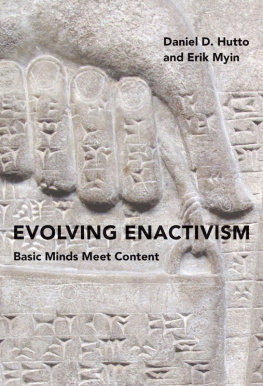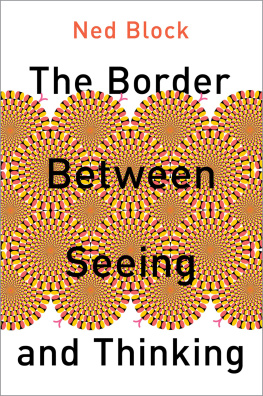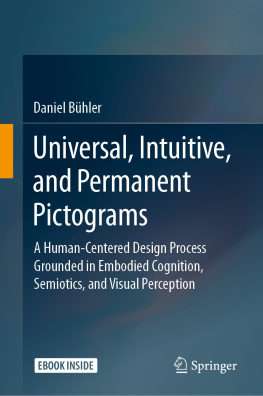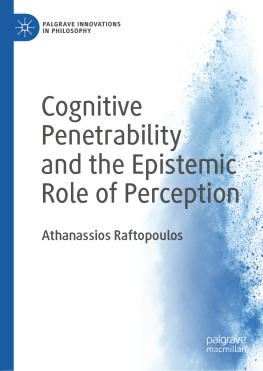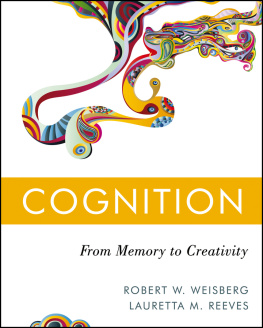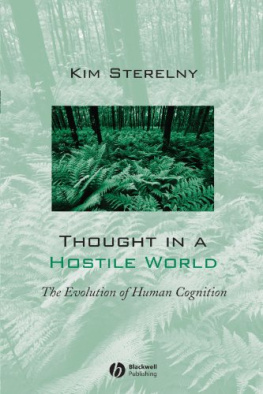
Evolving Enactivism
Basic Minds Meet Content
Daniel D. Hutto and Erik Myin
The MIT Press
Cambridge, Massachusetts
London, England
2017 Massachusetts Institute of Technology
All rights reserved. No part of this book may be reproduced in any form by any electronic or mechanical means (including photocopying, recording, or information storage and retrieval) without permission in writing from the publisher.
This book was set in ITC Stone Sans Std and ITC Stone Serif Std by Toppan Best-set Premedia Limited. Printed and bound in the United States of America.
Library of Congress Cataloging-in-Publication Data
Names: Hutto, Daniel D., author. | Myin, Erik, author.
Title: Evolving enactivism : basic minds meet content / Daniel D. Hutto and Erik Myin.
Description: Cambridge, MA : MIT Press, [2017] | Includes bibliographical references and index.
Identifiers: LCCN 2016039862 | ISBN 9780262036115 (hardcover : alk. paper)
eISBN 9780262339766
Subjects: LCSH: Philosophy of mind. | Cognitive science. | Act (Philosophy) | Intentionalism. | Mental representation. | Intentionality (Philosophy) | Phenomenology. | Content (Psychology)
Classification: LCC BD418.3 .H88 2017 | DDC 128/.2--dc23 LC record available at https://lccn.loc.gov/2016039862
ePub Version 1.0
For the children of the revolution,
Natura non facit saltum
Preface
Our entire picture of the world has to be altered even though the mass changes only by a little bit. This is a very peculiar thing about the philosophy, or the ideas, behind the laws. Even a very small effect sometimes requires profound changes in our ideas.
Richard Feynman, The Feynman Lectures on Physics
Classical physics got it wrong. Mass isnt a constant, independent of speedit increases with velocity, but only appreciably as its velocity approaches the speed of light. Does this matter? Feynmans answer is clear: Well, yes and no. For ordinary speeds we can certainly forget it and use the simple constant mass law as a good approximation. But for high speeds we are wrong, and the higher the speed, the more wrong we are. Finally, and most interesting, philosophically we are completely wrong with the approximate law (Feynman, Leighton, and Sands 1963, p. 12).
Of course, discovering we are completely wrong philosophically is what spurs on truly profound changes in our ideas. Feynman concludes that sometimes revolutions in thought ensue from what may seem, for most practical purposes, only small or marginal changes to a theoretical framework.
We couldnt agree more. In the spirit of moving philosophy and science ahead by making well-targeted adjustments to familiar ways of conceiving of mind and cognition, this book starts where its forerunner, Radicalizing Enactivism: Basic Minds without Content, left off. Our previous effort was devoted to promoting the fortunes of a Radically Enactive, Embodied account of Cognition, aka RECan account that conjectures that there could be, and very probably are, forms of cognition without content.
REC holds that some forms of cognition are content-involving in the sense that they represent the world in ways that might not obtainthat is, they represent it in ways that can be true or false, accurate or inaccurate, and so on. Yet it denies that the most fundamental forms of cognition involve contentfully representing the world or being contentfully informed about it in the sense of instantiating correctness conditions of some kind.
Making this twist to how we think about cognition is, from some angles, only a small adjustment, but it is also one thatas we aim to demonstrate in the pages aheadif accepted, could profoundly change our thinking about thinking.
In distinguishing basic, contentless from content-involving minds, REC seeks to tell the story of mind in duplex termsas a multi-storey story. In this REC opposes, and is flanked by, more common single-storey stories. It is flanked on the right by accounts of cognition that hold that Cognition always and everywhere Involves Content, aka unrestricted CIC. And it is flanked on the left by those theories that seek to eliminate content across the boardfor example, Really Radical Enactive, Embodied accounts of cognition, or RREC.
The changes REC aims to install in the way we think about thinking require theoretical adjustments to our conception of cognition, not mere verbal tweaks. Notably, some philosopherssuch as Huw Pricesubstantially agree with REC in thinking that there are two types of representation at large in cognition. Thus Price recognizes that there is a fundamental difference between responding to and keeping track of covariant information and making contentful claims and judgments that can be correct or incorrect. As he makes clear,
These two notions of representation should properly be kept apart, not clumsily pushed together. It takes some effort to see that the two notions of representation might float free of one another, but I think it is an effort worth making. Once the distinction between these two notions of representation is on the table, it is open to us to regard the two notions as having different applications, for various theoretical purposes. (Price 2013, 37)
Although Price and REC stand terminologically apart, we are together theoretically. It is unimportant that Price uses representation as a common label to describe what lies at the heart of two essentially different kinds of cognitive activity. Channeling our inner Freges, we think using the same label in such cases may invite confusion within the sciences of the mind. Still, in the end we follow Shakespeare on this score: Roses by other names!
Once its implications are recognized it is easy to see how RECs proposal excites fundamental disagreements about the character of cognition and the substantive properties that different forms of it are thought to have. For example, REC firmly disagrees with the unrestricted CIC view, now extremely popular in some quarters, that brains, oculomotor systems, and scientists, in doing their primary work, are all doing the same thingthat is, they all put forward contentful hypotheses about how things stand with the world (see, e.g., Hohwy 2013; Gerrans 2014; Clark 2016).
By RECs lights, this is a mistaken view. According to REC, the basic sorts of cognition that our brains help to make possible are fundamentally interactive, dynamic, and relational. RECs signature view is that such basic forms of cognition do not involve the picking up and processing of information that is used, reused, stored, and represented in the brain. The usual form of what REC calls basic, contentless cognition is nothing short of organisms actively engaging with selective aspects of their environment in informationally sensitive, spatiotemporally extended ways. The complex and cascading neural activity that enables this engagement does not involve representing how things stand with the world, but only anticipating, influencing, and coordinating responses in a strong, silent manner.
In promoting its peculiar bifold vision of cognition, Radicalizing Enactivism advanced a series of arguments explicitly targeting opposing views, giving the lions share of attention to the thesis of unrestricted CIC. That book placed a high priority on critiquing mainstream cognitive sciences foundational commitment to content-based information processing accounts of mind. It did so because raising doubts about the truth of unrestricted CIC was necessary in order to make the logical space for, and to motivate taking seriously, RECs positive vision of cognition.
Next page
